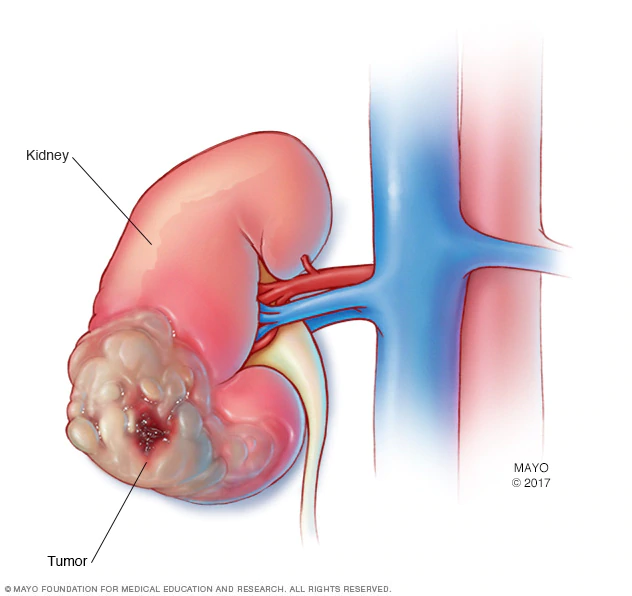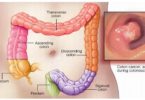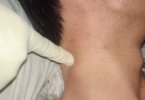What's in this article?
What is Kidney Cancer?
Kidney cancer also called renal cancer is a disease in which kidney cells become malignant (cancerous) and grow out of control, forming a tumor. Almost all kidney cancers first appear in the lining of tiny tubes (tubules) in the kidney. This type of kidney cancer is called renal cell carcinoma. The good news is that most of kidney cancers are found before they spread (metastasize) to distant organs. And cancers caught early are easier to treat successfully. However, these tumors can grow to be quite large before they are detected.
The kidneys are two bean-shaped organs, each about the size of a fist. They lie in your lower abdomen on each side of your spine. Their main job is to clean your blood, removing waste products and making urine.
Doctors don’t know the causes of kidney cancer. But certain factors appear to increase the risk of getting kidney cancer. For example, kidney cancer occurs most often in people older than age 40. These are some other risk factors for kidney cancer:
- Smoking . If you smoke cigarettes, your risk for kidney cancer is twice that of nonsmokers. Smoking cigars may also increase your risk.
- Being male. Men are about twice as likely as women to get kidney cancer.
- Being obese. Extra weight may cause changes to hormones that increase your risk.
- Using certain pain medications for a long time. This includes over-the-counter drugs in addition to prescription drugs.
- Having advanced kidney disease or being on long-term dialysis, a treatment for people with kidneys that have stopped working
- Having certain genetic conditions, such as von Hippel-Lindau (VHL) disease or inherited papillary renal cell carcinoma
- Having a family history of kidney cancer. The risk is especially high in siblings.
- Being exposed to certain chemicals, such as asbestos, cadmium, benzene, organic solvents, or certain herbicides
- Having high blood pressure. Doctors don’t know whether high blood pressure or medication used to treat it is the source of the increased risk.
- Being black. The risk in blacks is slightly higher than in whites. No one knows why.
- Having lymphoma. For an unknown reason, there is an increased risk of kidney cancer in patients with lymphoma.
Having these risk factors does not mean you will get kidney cancer. And it’s also true that you can have none of them and still get the disease.
What are kidney cancer causes and risk factors?
When you get a diagnosis of kidney cancer, it’s natural to wonder what may have caused the disease. Doctors usually can’t explain why one person gets kidney cancer and another doesn’t.
However, we do know that people with certain risk factors may be more likely than others to develop kidney cancer. A risk factor is something that may increase the chance of getting a disease.
Studies have found the following risk factors for kidney cancer:
- Smoking: Smoking tobacco is an important risk factor for kidney cancer. People who smoke have a higher risk than nonsmokers. The risk is higher for those who smoke more cigarettes or for a long time.
- Obesity: Being obese increases the risk of kidney cancer.
- High blood pressure: Having high blood pressure may increase the risk of kidney cancer.
- Family history of kidney cancer: People with a family member who had kidney cancer have a slightly increased risk of the disease. Also, certain conditions that run in families can increase the risk of kidney cancer.
- Von Hippel-Lindau (VHL) syndrome: VHL is a rare disease that runs in some families. It’s caused by changes in the VHL gene. People with a changed VHL gene have an increased risk of kidney cancer. They may also have cysts or tumors in the eyes, brain, or other parts of the body. Family members of those with VHL can have a test to check for a changed VHL gene.
Many people who get kidney cancer have none of these risk factors, and many people who have known risk factors don’t develop the disease.
Symptoms of kidney cancer
Most cases of kidney cancer don’t cause any symptoms in the early stages.
The most common symptoms of mid- to advanced-stage kidney cancer are:
- blood in your urine (haematuria) – the amount of blood is usually high enough to change the colour of your urine to a reddish or dark brown colour
- a persistent pain in your side, just below the ribs
- a lump or swelling in the area of your kidneys (on either side of the body)
However, in around half of all cases the cancer causes no symptoms and is only detected during a routine ultrasound scan.
Less common symptoms of kidney cancer include:
- extreme tiredness (fatigue) or anaemia
- unintentional weight loss
- a high temperature of 38C (100.4F) or above
- night sweats
- a general sense of feeling unwell
- swelling of the veins in the testicles (in men)
- loss of appetite
- high blood pressure (hypertension)
What are kidney cancer treatments?
Surgery
Surgery is the most common treatment for people with kidney cancer. The type of surgery depends on the size and stage of the cancer, whether you have two kidneys, and whether cancer was found in both kidneys.
You and your surgeon can talk about the types of surgery and which may be right for you:
- Removing all of the kidney (radical nephrectomy): The surgeon removes the entire kidney along with the adrenal gland and some tissue around the kidney. Some lymph nodes in the area may also be removed.
- Removing part of the kidney (partial nephrectomy): The surgeon removes only the part of the kidney that contains the tumor. People with a kidney tumor that is smaller than a tennis ball may choose this type of surgery.
There are two approaches for removing the kidney. The surgeon may remove the tumor by making a large incision into your body (open surgery). Or the surgeon may remove the tumor by making small incisions (laparoscopic surgery). The surgeon sees inside your abdomen with a thin, lighted tube (a laparoscope) placed inside a small incision. Sometimes a robot is used. The surgeon uses handles below a computer display to control the robot’s arms.
The surgeon may use other methods of destroying the cancer in the kidney. For people who have a tumor smaller than 4 centimeters and who can’t have surgery to remove part of the kidney because of other health problems, the surgeon may suggest:
- Cryosurgery: The surgeon inserts a tool through a small incision or directly through the skin into the tumor. The tool freezes and kills the kidney tumor.
- Radiofrequency ablation: The surgeon inserts a special probe directly through the skin or through a small incision into the tumor. The probe contains tiny electrodes that kill the kidney cancer cells with heat.
It takes time to heal after surgery, and the time needed to recover is different for each person. It’s common to feel weak or tired for a while.
Also, you may have pain or discomfort for the first few days. Medicine can help control your pain. Before surgery, you should discuss the plan for pain relief with your doctor or nurse. After surgery, your doctor can adjust the plan if you need more pain control.
Your health care team will watch you for signs of bleeding, infection, or other problems. They will keep track of how much fluid you take in and how much urine passes out of your body.
If one kidney is removed, the remaining kidney is usually able to do the work of both kidneys. However, if your remaining kidney isn’t doing a good job cleaning your blood, you may need dialysis. Some people may need a transplant with a healthy kidney from a donor.
You may want to ask your doctor these questions before having surgery:
- What type of surgery do you suggest for me? Do you recommend surgery that is through a large incision? Or through small incisions with a laparoscope? Do you recommend surgery with a robot?
- Will lymph nodes and other tissues be removed? Why?
- How will I feel after surgery? If I have pain, how can it be controlled?
- How long will I be in the hospital?
- When will I be able to return to normal activities?
- What are the long-term effects of the surgery? Will I need dialysis?
Targeted Therapy
People with kidney cancer that has spread may receive a type of drug called targeted therapy. Many kinds of targeted therapy are used for kidney cancer. This treatment may shrink a kidney tumor or slow its growth.
Usually, the targeted therapy is taken by mouth. You may feel very tired while taking targeted therapy for kidney cancer. Other side effects may include diarrhea, nausea, vomiting, sores on the lips or in the mouth, and high blood pressure.
Biological Therapy
People with kidney cancer that has spread may receive biological therapy. Biological therapy for kidney cancer is a treatment that may improve the body’s natural defense (the immune system response) against cancer. The treatments used for kidney cancer can slow the growth of tumors or shrink them. The biological therapy is injected intravenously or under the skin. The treatment may be given at the hospital or a doctor’s office.
Other drugs may be given at the same time to prevent side effects. The side effects differ with the biological therapy used, and from person to person. Biological therapy commonly causes a rash or swelling. You may feel very tired during treatment. The treatment may also cause a headache, muscle aches, a fever, or weakness.
You may want to ask your doctor these questions about targeted therapy or biological therapy:
- Why do I need this treatment?
- Which drug or drugs will I receive?
- How do the drugs work?
- When will treatment start? When will it end?
- How will I feel during treatment? What are the side effects? Are there any lasting side effects? What can I do about them?





